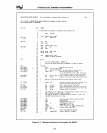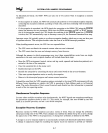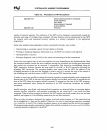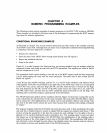
CHAPTER 4
NUMERIC PROGRAMMING EXAMPLES
The following sections contain examples of numeric programs for the 80287 NPX written
in
ASM286.
These examples are intended
to
illustrate some of the techniques
for
programming the
80287
comput-
ing system for numeric applications.
CONDITIONAL
BRANCHING
EXAMPLES
As
discussed
in
Chapter
Two,
several numeric instructions post their results
to
the condition code bits
of the 80287 status word. Although there are many
ways
to implement conditional branching following
a comparison, the basic approach
is
as
follows:
• Execute the comparison.
• Store the status word. (80287 allows storing status directly into AX register.)
• Inspect the condition code bits.
• Jump
on
the result.
r
Figure
4-1
is
a code fragment that illustrates
how
two
memory-resident long real numbers might be
compared (similar code could be used with the
FTST instruction). The numbers are called A and
B,
and the comparison
is
A
to
B.
The comparison itself requires loading A onto the top of the 80287 register stack and then comparing
it
to
B,
while popping the stack with the same instruction. The status word
is
then written into the
80286 AX register.
A and B have four possible orderings, and bits C3, C2, and
CO
of the condition code indicate which
ordering holds. These bits are positioned in the upper byte of the NPX status word
so
as
to
correspond
to the CPU's zero, parity, and carry flags
(ZF, PF, and CF), when the byte
is
written into the flags.
The code fragment sets
ZF, PF, and CF of the CPU status word
to
the values of C3, C2, and
CO
of
the NPX status word, and then uses the CPU conditional jump instructions to test the flags. The
resulting
codi:
is
extremely compact, requiring only seven instructions.
The FXAM instruction updates all four condition code bits. Figure
4-2
shows
how
a jump table can be
used to determine the characteristics of the value examined. The jump table
(FXA~TBL)
is
initial-
ized
to
contain the 16-bit displacement of
16
labels, one for each possible condition code setting. Note
that four
of the table entries contain the same value, because four condition code settings correspond
to
"empty."
The program fragment performs the FXAM and stores the status
word.
It
then manipulates the condi-
tion code bits
to
finally produce a number
in
register
BX
that equals the condition code times
2.
This
involves zeroing the unused bits
in
the byte that contains the code, shifting
C3
to the right
so
that
it
is
adjacent
to
C2, and then shifting the code
to
multiply it by
2.
The resulting value
is
used
as
an index
that selects one of the displacements from
FXA~TBL
(the multiplication of the condition code
is
required because of the 2-byte length of each value in FXAM_TBL). The unconditional JMP instruc-
tion effectively vectors through the jump table
to
the labelled routine that contains code (not shown in
the example) to process each possible result of the FXAM instruction.
4-1


















